Food Allergy & Anaphylaxis
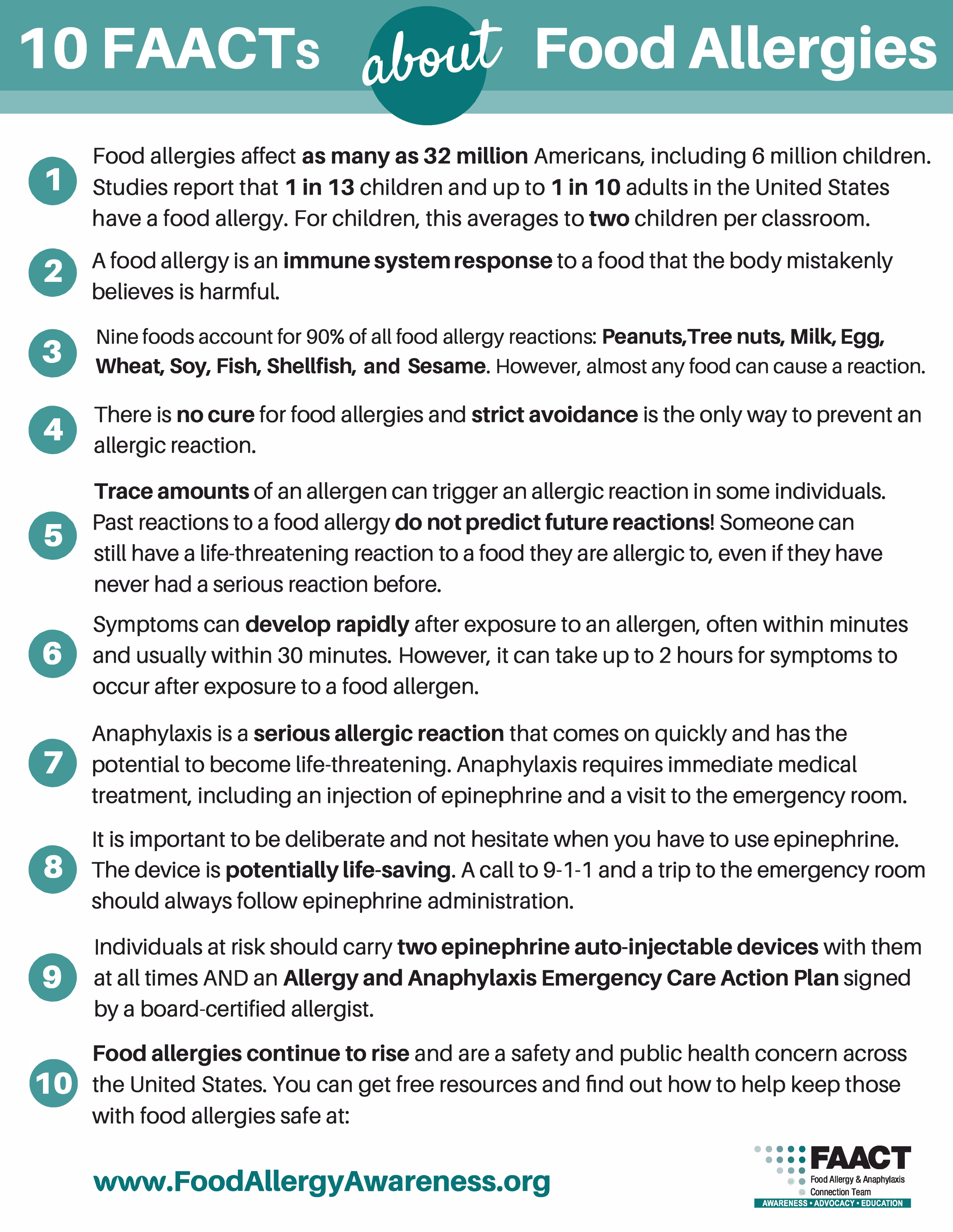
Food Allergy Basics
- Food allergies affect as many as 32 million Americans, including 26 million adults and 5.6 million children.
- Food allergy affects approximately 7.6 percent(1) of children and 10.8 percent(2) of adults in the United States.
- The Centers for Disease Control and Prevention (CDC) report that although food allergy is more prevalent in children(3) than adults, many affected children can “outgrow” food allergies with age.
- The Centers for Disease Control & Prevention (CDC) reports that the prevalence of food allergy in children increased by 50 percent between 1997 and 2011(5).
- A food allergy is an immune system response to a food the body mistakenly believes is harmful.
- When a person with food allergy eats the food, his or her immune system releases massive amounts of chemicals, including histamine, that trigger a cascade of symptoms that can affect the respiratory system, the gastrointestinal tract, the skin, and/or the cardiovascular system.
- There is no cure for food allergies(3).
- The prevalence of food allergies appears to be increasing among children under the age of 18, that is 2 students in every classroom.
- Although food allergy desensitizations are being studied, these are not yet proven treatments, so strict avoidance is the only way to prevent an allergic reaction.
- Managing a food allergy on a daily basis involves constant vigilance.
- Trace amounts of an allergen can trigger an allergic reaction in some individuals.
- Unfortunately, food allergy deaths do occur, even among persons with a history of mild reactions in the past.
- 9-1-1 must ALWAYS be called with every anaphylactic reaction.
Download 10 FAACTs about Food Allergies poster.
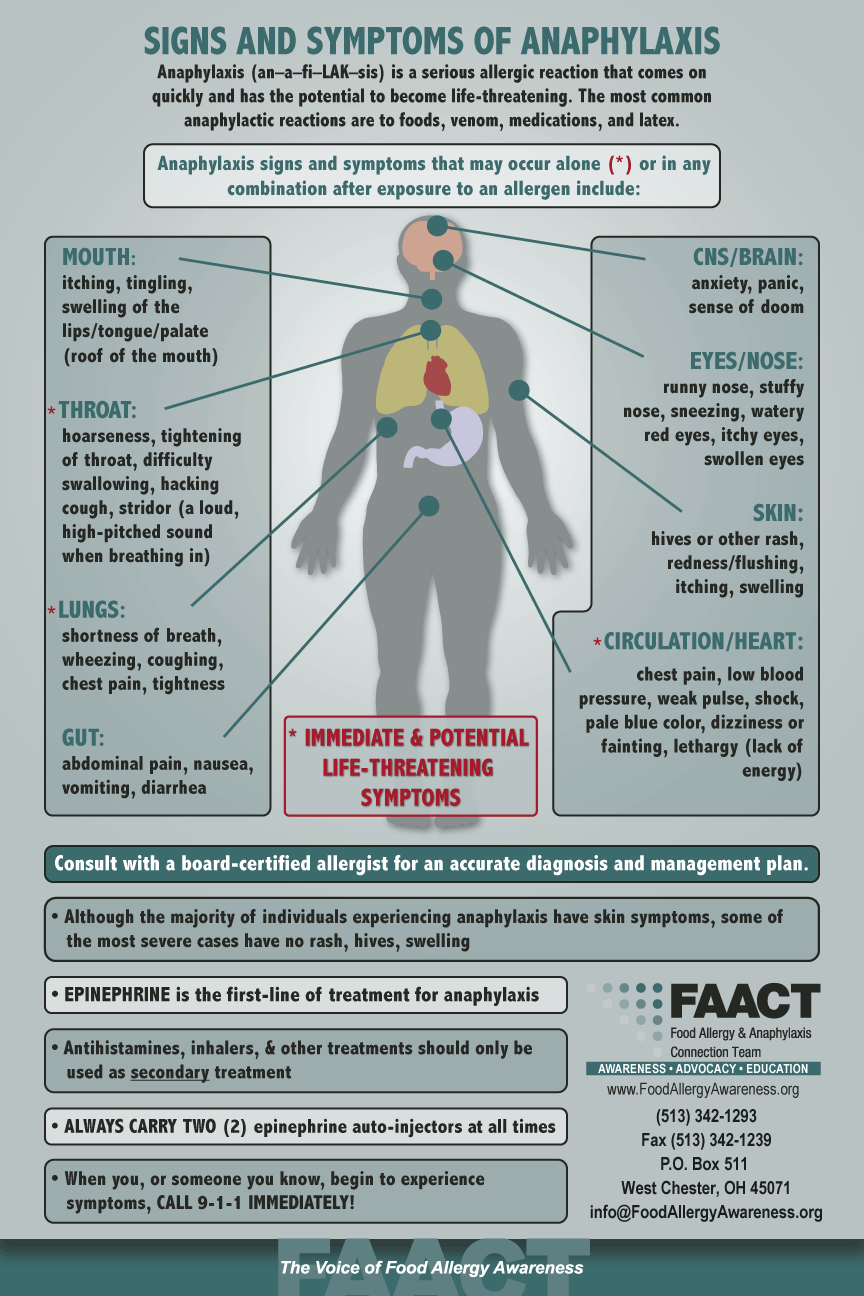
Anaphylaxis (an–a–fi–LAK–sis)
- Is a serious allergic reaction that comes on quickly and has the potential to become life-threatening.
- Food, latex, insect stings and medicines can cause a severe allergic reaction(3).
- Anaphylaxis includes a wide range of signs and symptoms that can occur alone, or in combination, after exposure to an allergen.
- Symptoms can develop rapidly after exposure to an allergen, often within minutes and usually within 30 minutes. However, it can take up to 2 hours for symptoms to occur after exposure to a food allergen.
- Anaphylaxis requires immediate medical treatment, including admninistration of epinephrine and a visit to the emergency room. Anaphylaxis can be fatal if not treated promptly.
- Observation in a hospital for a period between 4 and 24 hours is recommended once the individual has returned to normal, due to concerns of biphasic anaphylaxis.
- If you or someone you know is at risk of anaphylaxis, two epinephrine auto-injectable devices must be carried at all times.
- Sometimes a second round (or “phase”) of allergic reactions can occur after the initial anaphylactic reaction. This is called “biphasic anaphylaxis”. A second reaction may happen as early as an hour after the first reaction or as long as 72 hours later (the average is 10 hours later) and can be less severe, as severe, or even more severe than the initial reaction.
Prompt administration of epinephrine is crucial to surviving a potentially life-threatening reaction. Epinephrine has very few side effects. It is prescribed as an auto-injector device (Auvi-Q®, EpiPen®).
Each year in the U.S., it is estimated that severe reactions to food cause:
- 30,000 emergency room visits
- 2,000 hospitalizations
- 150 deaths(4)
Anaphylaxis: Signs and Symptoms Poster
Allergy & Anaphylaxis Emergency Plan (AAP)
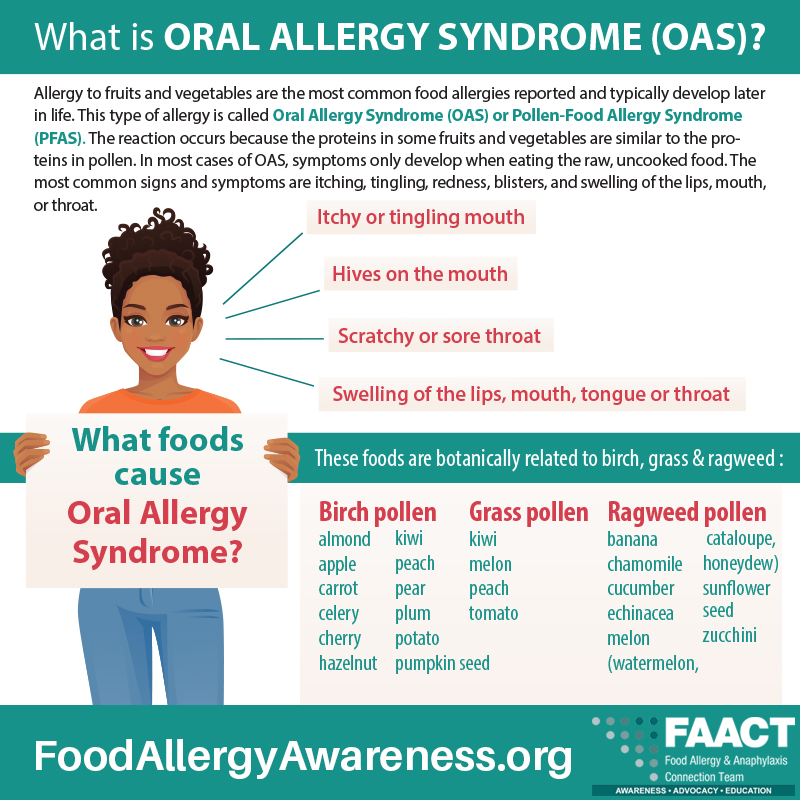
Oral Allergy Syndrome
Allergy to fruits and vegetables are the most common food allergies reported by adults and typically develop later in life. This is called Oral Allergy Syndrome (OAS) or Pollen-Food Allergy Syndrome (PFAS)—a reaction that occurs because the proteins in some fruits and vegetables are similar to the proteins in pollen.
In most cases of OAS, symptoms only develop when eating the raw, uncooked food. The most common symptoms are itching, tingling, redness, blisters, and swelling of the lips, mouth, or throat.
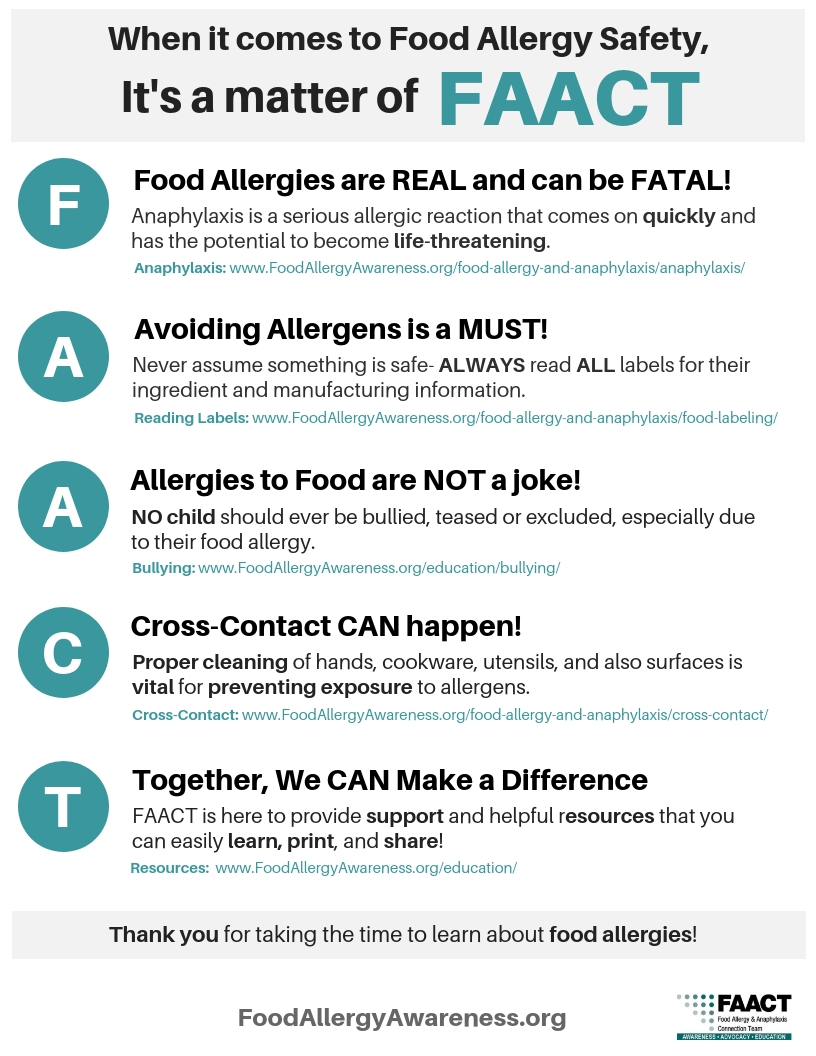
When It Comes to Food Allergy Safety, It’s a Matter of FAACT!
Food Allergies are REAL and can be FATAL! Anaphylaxis is a serious allergic reaction that comes on quickly and has the potential to become life-threatening.
Avoiding Allergens is a MUST! Never assume something is safe - ALWAYS read ALL labels for their ingredient and manufacturing information.
Allergies to Food are NOT a joke! NO child should ever be bullied, teased or excluded, especially due to their food allergy.
Cross-Contact CAN happen! Proper cleaning of hands, cookware, utensils, and also surfaces is vital for preventing exposure to allergens.
Together, We CAN Make a Difference! FAACT is here to provide support and helpful resources that you can easily learn, print, and share!
Download Food Allergy Safety, It's a Matter of FAACT poster.
A food allergy is NOT:
- A food intolerance (lactose intolerance, gluten intolerance, etc.).
- An intolerance does not involve the immune system – it involves the digestive system because the body lacks an enzyme needed to digest and process a particular food.
- Symptoms of an intolerance include gas, bloating, and abdominal pain.
- A food preference (vegetarian, kosher, etc.).
- Celiac Disease (is a NON-IgE mediated food allergy).
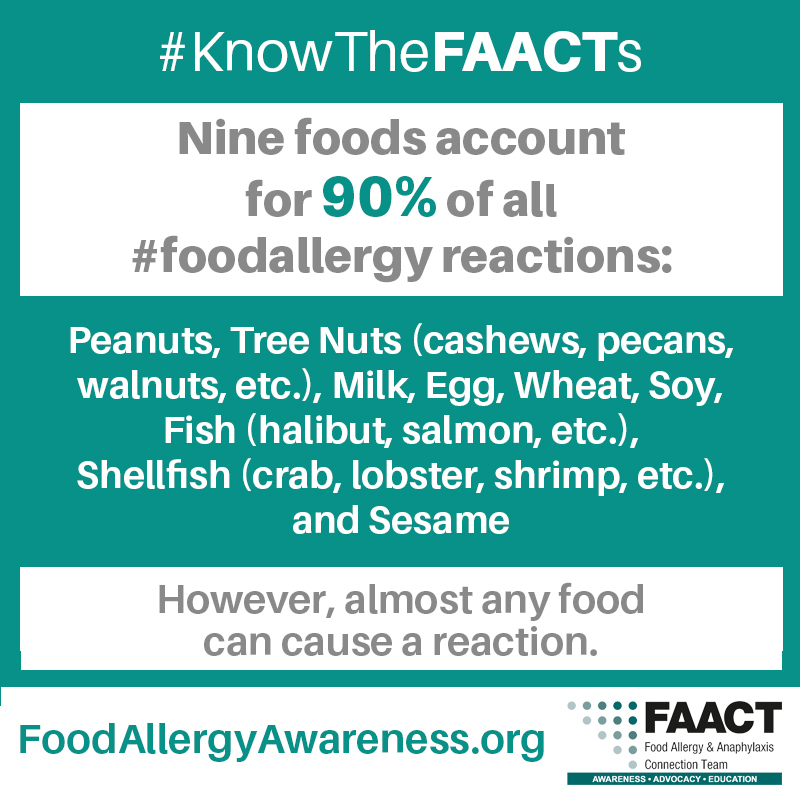
Nine foods account for 90 percent of all food allergy reactions:
- Peanuts
- Tree nuts (cashews, pecans, walnuts, etc.)
- Milk
- Egg
- Wheat
- Soy
- Fish (halibut, salmon, etc.)
- Shellfish (crab, lobster, shrimp, etc.)
- Sesame
While more than 170 foods can cause allergic reactions in people with food allergies, the law identifies the nine most common allergenic foods (4). Visit FAACT's Education Resource Center for FREE and downloadable resources.
To learn more about food allergy, we recommend the video “Understanding Food Allergy” by the National Institute of Allergy and Infectious Diseases.

Avoid high-risk types of restaurants
Persons with food allergies should generally avoid high-risk types of restaurants, including:
- Buffets and deli stations (risk of cross-contact).
- Bakeries and ice cream shoppes (risk of cross-contact).
- Asian cuisine (peanuts, tree nuts used in many dishes).
- Ethnic and international restaurants (language barrier).
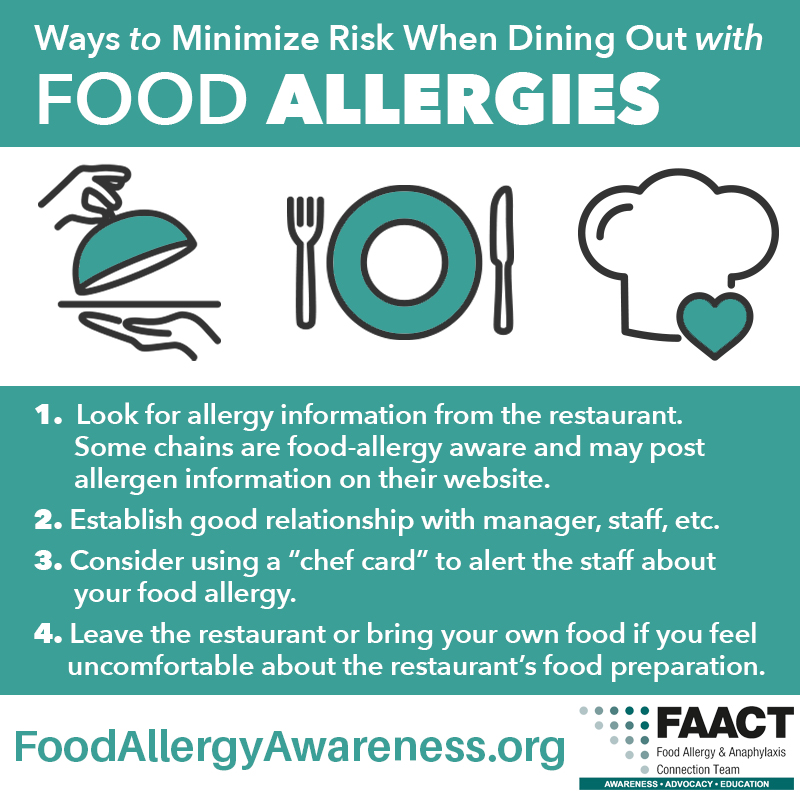
Minimize risk
There are ways to minimize risk of accidental exposures and feel more secure about eating out.
- Look for allergy information from the restaurant. Some chains are food-allergy aware and may post allergen information on their Web site.
- Establish good relationship with manager, staff, etc.
- Consider using a “chef card” to alert the staff about your food allergy.
- Leave the restaurant or bring your own food if you feel uncomfortable about the restaurant’s food preparation.
For more information about food allergies, contact FAACT, and visit FAACT's Education Resource Center for FREE and downloadable resources.
References
4. Boyce JA, Assa’ad A, Burks AW, et al; NIAID-Sponsored Expert Panel. Guidelines for the diagnosis and management of food allergy in the United States: report of the NIAID-sponsored expert panel. J Allergy Clin Immunol. 2010;126(suppl 6):S1-S58. Available at: https://www.ncbi.nlm.nih.gov/pmc/articles/PMC4241964/